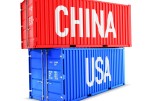Swissquote: The disconnect grows
Swissquote: The disconnect grows

The market reaction to the weekend’s tariff threats — this time targeting a 30% tariff on Mexican and European exports to the US — was mostly hopeful: that they won’t materialize. That’s how markets traded the news — on the assumption that negotiations will water things down to a 15%-ish rate, at least for the Europeans.
As such, losses in European stock markets remained contained, with the Stoxx 600 closing the session near flat, holding above the 50-day moving average. Major US indices even eked out gains, with the S&P500 hovering just a few points below all-time highs. All this, despite EU politicians’ retaliation plans targeting $84 billion worth of US goods — including cars, bourbon, and Boeing planes. Anyone care?
One bright spot: Nvidia has reportedly been cleared to resume selling its H20 chips to China. Given that the risks to its Chinese business were already broadly priced in, this could provide a tailwind. China also printed stronger-than-expected growth and industrial production figures this morning. But beyond that, the broader news remains less than encouraging — yet equity futures are in the green.
The disconnect
Meanwhile, the sovereign bond space is flashing warning signals. Long-term yields are spiking. Japan’s 30-year yield surged nearly 18bps on Monday and climbed further this morning to 3.20% — historically high territory. Investors are bracing for the possibility that the LDP maintains its majority in Sunday’s Upper House election, which would likely be seen as a mandate for further fiscal expansion — and fuel concerns over Japan’s already precarious debt sustainability.
PS: the Japanese government had already announced a reduction in the supply of these long bonds last month in an effort to calm the selloff — but the fears persist. Rising Japanese yields are having a domino effect across Western sovereign markets. The US 30-year yield continues flirting with the 5% psychological threshold, and a broad gauge of European 10-year yields spiked past 2.70%.
Rising yields are bad news for global risk appetite — or at least they should be in a rational market — as they imply higher borrowing costs for businesses. But again, no one seems to care.
Risks are piling up
Risks are piling up: the risk of global supply chain disruptions, a tariff-led jump in US inflation, pressure on company earnings, an unsustainable surge in G7 debt levels, political risks, geopolitical risks... Even if Trump backs down for now, the measures already in place — coupled with rising borrowing costs — will have real-world consequences sooner rather than later.
For US companies, the dollar’s more than 10% depreciation in H1 is expected to provide a boost to earnings, as roughly 40% of S&P500 revenues come from abroad and will translate into higher dollar revenue when converted back for reporting. But European companies won’t benefit from currency relief. The euro and Swiss franc appreciated significantly in the first half of the year. On top of that, many companies chose to ‘eat the tariffs’ — absorbing the cost to preserve their US market share while waiting for the trade dust to settle. This will show up somewhere — but markets don’t seem to have priced it in yet.
US banks kick off earnings
US big banks will start reporting Q2 earnings in the coming hours and days, and they’re expected to post a 1% decline in Q2. Meanwhile, the S&P500 Financials sector has rallied roughly 24% since the April dip. Looser regulations may be one reason behind the rally, as investors anticipate more lending capacity and better margins — yet the 24% rally barely matches the 1% decline in earnings. The bad news is that a 1% earnings drop is not great news. The good news is that it sets a low bar. If expectations are beaten, the rally could continue — despite the earnings decline. But slowing earnings will eventually make valuations too rich to ignore.
Even though the consensus expects a decent US earnings season, the widening gap between investor optimism and economic reality increases the risk of a sharp reversal. The more investors ignore troubling signals, the higher the chance of a painful correction.
On the macro front, the US will release its latest CPI data today. Both headline and core inflation are expected to accelerate from 0.1% to 0.3% MoM in June, driven by tariff-related pressures on cars, toys, furniture, and other exposed goods. Recent downside surprises in inflation were largely due to companies offloading existing stockpiles — built up ahead of tariff implementation. But those buffers are shrinking, and new imports will inevitably show up in prices. If inflation doesn't rise, it will mean companies are absorbing the costs — again, someone will pay. Whether it's the American consumer or the foreign exporter depends on product-level price sensitivity.
So, something has to give — but when and where remains the big unknown. It’s worth watching the economic data, the earnings, and global yields closely.









